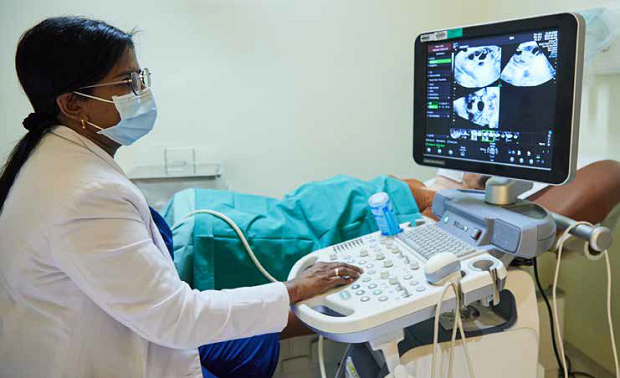
It is not all about pictures in the ultrasound room. For sonographer Vijeyaletchimi Nadasan, an important aspect of her job is to assure anxious women struggling to conceive.
She counts eggs. Women’s eggs,
that is.
It is what Ms Vijeyaletchimi Nadasan does every day as a specialist sonographer at Singapore General Hospital’s (SGH) Centre for Assisted Reproduction (CARE), a one-stop fertility centre under the Department of Obstetrics and Gynaecology.
“My job is to check the number of eggs that the ovaries can produce and that can be retrieved later for in-vitro fertilisation (IVF),” said the Senior Principal Sonographer. “I trace, count and measure every single follicle that is going to mature and ovulate, starting from the second day of a patient’s menstruation cycle. We track the progress of these follicles until it is time for ovulation.”
Follicles contain eggs with the potential to mature. When one reaches around 18 millimetres, it is ready and must be retrieved within the short window of time available for fertilisation. Scanning a follicle takes 5–10 minutes, or 20–30 minutes for multiple follicles.
IVF sonographers at SGH and sister institution, KK Women’s and Children’s Hospital, journey with couples through the many stages of a pregnancy, from the check-ups and diagnoses for fertility issues to follicle tracking and pregnancy. When undergoing their ultrasound scans, patients may become anxious, which can affect the quality of the ultrasound images taken. It is important for sonographers to be able to calm their patients.
To get them to relax, Ms Vijeyaletchimi.
often tells them about a patient who was
found to have only one good egg. The patient
managed to have that single egg retrieved,
fertilised and implanted. She became
pregnant and delivered a healthy baby. “I
always tell my patients: you don’t need too
many eggs. You just need one good egg to get pregnant. Look forward to that,” said
Ms Vijeyaletchimi.

How sonographers communicate with their patients is also crucial. “We must listen to our patients actively and carefully. Choosing the right words, understanding their state of mind,” she said.
It is a different ball game when scanning the foetus to track its growth, health and other developmental milestones. Unlike an adult who keeps still when asked, the foetus is constantly moving, making it difficult to scan different parts of its body. One solution is to have the mother go for a walk before resuming the procedure, when the foetus has changed its position, and a different part of the body can be scanned.
Not only do the scans assure parents of a foetus’ healthy development, seeing the baby’s heartbeat, movements and features helps create a stronger bond and connection between parents and child. “Some of them have had multiple miscarriages and are anxious when they come in, so I try to get the best images of the baby’s features to show them,” said Ms Vijeyaletchimi.
A keen science student in school, Ms Vijeyaletchimi settled on radiography after her sister, then a nursing officer at SGH, told her of available positions at the hospital. In the 1980s, radiography was considered unconventional, in part because of concerns over potential radiation and its effects. Ms Vijeyaletchimi was undeterred. She has since been trained in various aspects of radiography, including x-ray, CT (computed tomography) and MRI (magnetic resonance imaging). She chose to specialise in sonography, finding it so fascinating that when an advanced diploma course was introduced, she took up night classes while pregnant with her third child.
When she left for a period to work in a private hospital, she performed ultrasound scans on various areas of the body, including breast, testes, prostate and thyroid. Returning to SGH in 2010, she focused on ultrasound for obstetrics and gynaecology patients. Today, she performs an average of 16 scans daily, including IVF-related as well as foetal abnormalities and fallopian tube blockages.
Having witnessed the beginning of life multiple times, Ms Vijeyaletchimi cherishes her recently acquired role as grandmother. Weekends are spent with her 15-month-old grandchild at the library, pool and parks. In her free time, she practises yoga once a week and enjoys the company of her Maltese- Poodle mix, Robin.
Get the latest updates about Singapore Health in your mailbox! Click here to subscribe.













 Get it on Google Play
Get it on Google Play